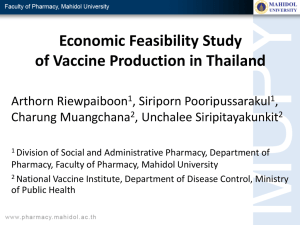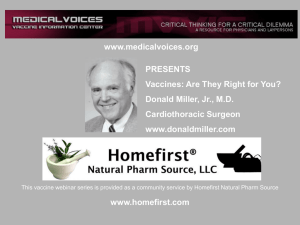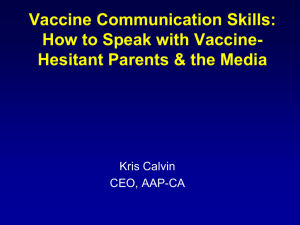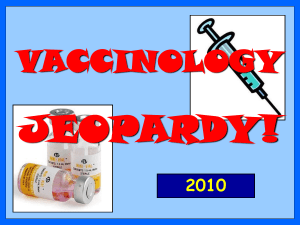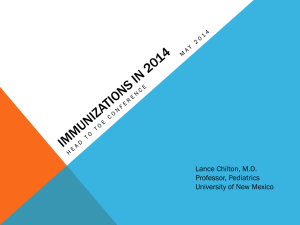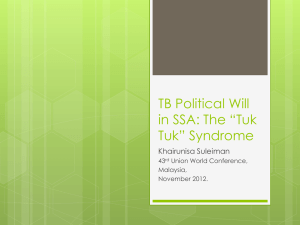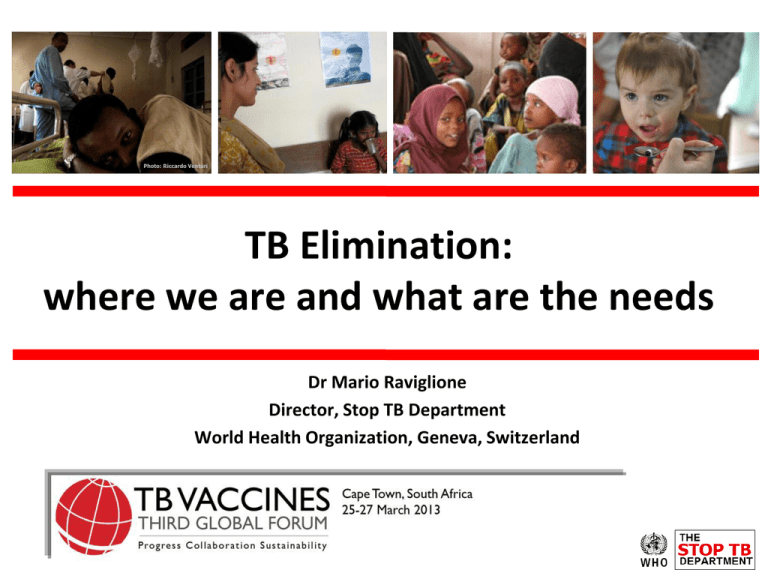
Photo: Riccardo Venturi
TB Elimination:
where we are and what are the needs
Dr Mario Raviglione
Director, Stop TB Department
World Health Organization, Geneva, Switzerland
Overview
Quick overview of global burden of TB
Impact of interventions and progress
Is elimination possible in our lifetime?
What is needed to accelerate
incidence decline?
What can be done today?
Overview
Quick overview of global burden of TB
Impact of interventions and progress
Is elimination possible in our lifetime?
What is needed to accelerate
incidence decline?
What can be done today?
The Global Burden of TB -2011
Estimated number
of cases
All forms of TB
8.7 million
(8.3–9.0 million)
HIV-associated TB
Multidrug-resistant TB
Estimated number
of deaths
1.4 million*
(1.3–1.6 million)
1.1 million (13%)
430,000
(1.0–1.2 million)
(400,000–460,000)
Up to 0.5 million
Unknown, but
probably > 150,000
Source: WHO Global Tuberculosis Report 2012
* Including deaths attributed to HIV/TB
Incidence rates, 2011
0–24
25–49
50–149
150–299
≥300
Per 100 000 population
Highest rates in Africa, linked to high rates of HIV infection
~80% of HIV+ TB cases in Africa
Estimated number of MDR-TB Cases, 2011
>60% of all cases are in 6 countries
Russian Federation
44,000
(14% of global MDR burden)
China
61,000
(20% of global MDR
burden)
South Africa
8,100
Based on old
survey data
Pakistan
10,000
(3% of global MDR
burden)
India
66,000
Philippines
11,000
(21% of global MDR
burden)
(4% of global
MDR burden)
The boundaries and names shown and the designations used on this map do not imply the expression of any opinion whatsoever on the part of the World Health Organization concerning
the legal status of any country, territory, city or area or of its authorities, or concerning the delimitation of its frontiers or boundaries. Dotted lines on maps represent approximate border
lines for which there may not yet be full agreement.
WHO 2012. All rights reserved
Overview
Quick overview of global burden of TB
Impact of interventions and progress
Is elimination possible in our lifetime?
What is needed to accelerate
incidence decline?
What can be done today?
The global response:
Targets, Global Plan, and Stop TB Strategy
Goal 6: to have halted
by 2015 and begun
to reverse the
incidence…
2015: 50% reduction in TB
prevalence and deaths
compared to 1990
2050: elimination (<1 case
per million population)
1.
Pursue high-quality DOTS
expansion
2.
Address TB-HIV, MDR-TB, and
needs of the poor and
vulnerable
3.
Contribute to health system
strengthening
4.
Engage all care providers
5.
Empower people with TB and
communities
6.
Enable and promote research
TB cases and deaths, 1990–2011: achievements of
control efforts with available tools (absolute numbers)
Incidence
Mortality
10
1.5
HIV-negative
mortality
All cases
7.5
Millions
1.0
5
Total mortality peaked early
2000s at >1.8 million
1.4 million in 2011
Peak > 9 in early 2000s
8.7 million in 2011
0.5
2.5
0
HIV-positive
mortality
HIV-positive cases
0
The case detection/notification gap
Global notifications
Estimated incidence
NO elimination
without “capturing”
them
8.7
7.8
TB cases (millions)
Nearly 3 million TB
cases either not
notified or not
detected
10
5.8
5
3.7
0
1990
2000
2010
Global Progress on impact
51 million patients
cured, 1995-2011
20 million lives saved
since 1995
2015 MDG and other
international targets on
track
BUT, TB incidence
declining far too slowly,
1/3 of cases not in the
system, MDR-TB untackled etc.
Overview
Quick overview of global burden of TB
Impact of interventions and progress
Is elimination possible in our lifetime?
What is needed to accelerate
incidence decline?
What can be done today?
Full implementation of Global Plan: 2015 MDG
target reached but TB not eliminated by 2050
Current rate of
decline -2%/yr
China,
Cambodia
China, Cambodia
-4%/yr
-4%/yr
W Europe after WWII
-10%/yr
Elimination target:<1 / million / yr
-20%/yr
Decline in TB burden in China and Cambodia
Incidence
Prevalence
Recipe:
-3.4%/yr
-5%/yr
China
Sustained socioeconomic
development
Stop TB Strategy with
adequate resources
TB care subsidized and
decentralised
-3%/yr
-7%/yr
Cambodia
BCG vaccination in
infants
Full implementation of Global Plan: 2015 MDG
target reached but TB not eliminated by 2050
Current rate of
decline -2%/yr
China, Cambodia
-4%/yr
WW
Europe
WWII
Europeafter
after WWII
-10%/yr
-10%/yr
Elimination target:<1 / million / yr
-20%/yr
TB incidence declined 10%/year
after WWII in Europe (the Netherlands)
-10%/year
Recipe:
Sustained socio-economic
development
Universal health coverage &
social protection
TB care widely accessible
BCG vaccination in children
Screening of high-risk groups
(but limited impact)
Infection control practices (?)
Nat Rev Microbiol 2012; 10: 407–16.
Full implementation of Global Plan: 2015 MDG
target reached but TB not eliminated by 2050
Current rate of
decline -2%/yr
Eskimos
> 10 ; < 20
China, Cambodia
-4%/yr
W Europe after WWII
-10%/yr
Elimination target:<1 / million / yr
-20%/yr
Eskimos in Alaska, NW Canada and Greenland:
15% per year incidence decline
Recipe:
-17%/year
(1955-74)
Highly focused & high
intensity interventions
Screening and massive
TLTBI
TB care decentralised
BCG vaccination
Improved health access &
social protection
Economic development (?)
-8.7%/year
(1972-74)
Grzybowski S, Styblo K, Dorken E. Tuberculosis in Eskimos. Tubercle
1976; (suppl.) 57: 1-58
Can TB control among Eskimos be generalised to
the world?
Full implementation of Global Plan: 2015 MDG
target reached but TB not eliminated by 2050
Current rate of
decline -2%/yr
China, Cambodia
-4%/yr
W Europe after WWII
-10%/yr
Elimination
target:<1
/million/yr
Elimination target:<1
/ million
/ yr
-20%/yr
-20%/yr
Overview
Quick overview of global burden of TB
Impact of interventions and progress
Is elimination possible in our lifetime?
What is needed to accelerate
incidence decline?
What can be done today?
What is needed to accelerate incidence decline and
target "elimination"?
Economic development: better nutrition & housing
Universal health coverage & social protection
TB care widely accessible to all and of high-standards
Focused, high-intensity interventions, including BCG in children
Screening of high-risk groups and mass TLTBI
Infection control practices
However… while incidence decline can accelerate, “elimination” is
another story, as it requires major reduction of:
(i) transmission rate, and
(ii) reactivation of latent infection among the already infected
In turn, this requires…new tools and increased financing
What is in the pipelines for new diagnostics,
drugs and vaccines in 2013?
Diagnostics:
₋ 7 new diagnostics or diagnostic
methods endorsed by WHO since 2007;
₋ 6 in development;
₋ yet no PoC test envisaged
Drugs:
- 1 new drug approved in late 2012, but
probably little impact on epidemiology;
- 1 expected to be approved in 2013;
- a regimen and other 2-3 drugs likely to be
introduced in the next 4-7 years
Vaccines:
₋ 11 vaccines in advanced phases of
₋ development;
₋ 1 just reported with no detectable efficacy
Pipeline promising, but what do we need to eliminate TB?
Potential impact of new tools on TB incidence in S-E Asia
Source: L. Abu Raddad et al, PNAS 2009
To eliminate TB:
1. Very short potent regimen for all forms, and
2. Simple regimen for mass chemoprophylaxis
Synergy of interventions !
Action on both transmission and reactivation pathways
•Led & NAAT at microscopy lab level
•Dipstick at point of care
•Regimen 1 = 4-month, no effect on DR
•Regimen 2 = 2-month, 90% effective in M/XDR
•Regimen 3 = 10-day, 90% effective in M/XDR
Or:
Mass pre- and post-exposure vaccine
Add. Effects = effects also on latency
and infectiousness of cases in vaccinated
Tools required for eradication in our lifetime (1: drugs):
Do we have potent regimen for (a) treatment and (b) prevention?
Ideally, we need as short a regimen as possible active against all
types of TB, transforming TB into a common infectious disease.
However, we only have “short-course chemotherapy”
Ideally, we need mass chemoprophylaxis (TLTBI), as TLTBI
prevents reactivation with up to 70% efficacy. However:
Safety issue on a mass scale: fatal hepatitis
• 4.13 (95% CI 0.5-34) Risk Ratio (vs placebo) (Cochrane Review, 2010);
• 4-7/100,000 incidence (Millard PS et al. West J Med. 1996;164:486-91.)
Single dose treatment not available: no existing drug kills intracellular
bacteria (such as M. tuberculosis) in a non-replicative state
Screening of truly infected or at real risk not available: no “IGRA-plus”
Tools required for eradication in our lifetime:
(1a) A potent regimen for treatment
Assessment of fluoroquinolone trials in early 2014
Three trials:
OFLOTUB/Gatifloxacin for TB Phase III trial: gatifloxacin substituted for ethambutol – 4
months Rx - results expected second half 2013
ReMox: moxifloxacin substituted for ethambutol or isoniazid – 4 months Rx - results
expected early 2014
Rifaquin trial: moxifloxacin substituted for ethambutol (intensive phase), associated with
rifapentine once weekly in continuation phase – presentation at CROI 2013. 4-month arm
did not work
NC-001 regimen: PA-824, pyrazinamide, moxifloxacin
Tools required for eradication in our lifetime:
(1b) do we have a potent regimen for prevention?
1. WHO recommends treatment of LTBI for:
• People living with HIV (PLHIV)
• Children <5 contacts of a TB case
• Recent TST converters
2. IPT prevents TB with around 70% efficacy
3. Isoniazid 5 mg/kg daily (max 300 mg) for at least
6 months. Other shorter regimens efficacious
(12wHP, 3HR)
4. Individual benefits clear, population level less
clear (40% reported)
5. Modelling shows potential, but feasibility and
scale-up remain an issue
Implementation of IPT on a large scale is a
challenge even in PLHIV
Number of PLHIV on IPT
increased in the past few years
But…only 450,000 started on
IPT out of 3.2 million people
screened for TB in HIV care
settings in 2011
Completion rate in various
studies varies 47-94%
Concerns by providers over
side effects (real) and creation
of drug resistance (not
substantiated)
Reality check about treatment and chemoprophylaxis
1. Today we do not have a potent treatment regimen
that lasts <2 months and treats TB and M/XDR-TB. It
will probably not be available for at least 5-10 years
2. Today we do have a treatment for latent TB infection
that is 70% efficacious, but difficult to scale-up to
whole population (? 2 billion infected) or even to
high-risk groups
3. Today we do not have a test capable of identifying
who will progress to active TB among the ?2 billion
infected
Tools required for eradication in our lifetime (2: Vaccines):
Perspectives for a potent vaccine
Mass vaccination with a potent vaccine:
– pre-exposure:
would prevent infection to occur, and therefore disease,
but impact would take a long time to appear
– post-exposure:
would prevent “reactivation”, and would have impact on
transmission as new cases will not emerge any longer out
of the pool of already infected. However, it would not
prevent new infection
BCG evidence and MVA85A phase 2b trial results
• BCG: efficacy in disseminated pediatric forms proven. Efficacy against adult
contagious forms variable. Revaccination efficacy nihil or dubious
• MVA85A:
Safe
Showing it is feasible to test vaccine candidates in large trials, but…
No detectable efficacy
Global TB Vaccine Pipeline 2013:
good but needs to keep growing
Reality check about vaccines
Phase II
VPM 1002
Max Planck, VPM,
TBVI
Phase IIb
Phase III
1.Today we do not have a potent pre- and
post-exposure vaccine, we have BCG
Ad5 Ag85A
McMaster CanSino
ID93 + GLA-SE
IDRI, Aeras
Hybrid-I + IC31
SSI, TBVI, EDCTP,
Intercell
MVA85A/AERAS485
OETC, Aeras
AERAS-402/ Crucell
Ad35
Crucell, Aeras
2.Today we do not have yet clarity about
correlates of immunity and bio-markers
Hyvac 4/ AERAS-404
+ IC31
SSI, sanofi-pasteur,
Aeras, Intercell
H56 + IC31
SSI, Aeras, Intercell
RUTI
Archivel Farma, S.L
M72 + AS01
GSK, Aeras
M. Vaccae
Anhui Longcom,
China
3.Today, we do not fully understand
pathogenesis and immunity
MTBVAC
TBVI, Zaragoza,
Biofabri
Hybrid-I + CAF01
SSI, TBVI
Viral vector
rBCG
Protein/adjuvant
Attenuated M.tb
Immunotherapeutic:
Mycobacterial – whole cell
or extract
32
Overview
Quick overview of global burden of TB
Impact of interventions and progress
Is elimination possible in our lifetime?
What is needed to accelerate
incidence decline?
What can be done today?
What can be done?
1. Enhance strategy and approach
to TB care, control and research
2. Mobilize resources for research
3. Build full commitment
Enhanced TB Strategy Post-2015 (draft)
Targets (draft) : 75% reduction of deaths
(and 40% reduction in incidence by 2025)
Innovative TB Care
Rapid diagnosis of TB including
universal drug-susceptibility testing ;
systematic screening of contacts and
high-risk groups
Treatment of all forms of TB
including drug -resistant TB with
patient support
Bold policies and supportive
systems
Government stewardship , commitment,
and adequate resources for TB care and
control with monitoring and evaluation
Engagement of communities , civil
society organizations, and all public and
private care providers
Collaborative TB/HIV activities and
management of co-morbidities
Regulatory framework for vital
registration, case notification, drug
quality and rational use, and infection
control
Preventive treatment for high-risk
groups and vaccination of children
Universal Health Coverage, social
protection and other measures to
address social determinants of TB
Intensified Research
Discovery, development and rapid
uptake of new diagnostics, drugs
and vaccines
Operational research to optimize
implementation and adopt
innovations
Setting targets: Projected decline in TB mortality
to reach “zero” deaths (and cases…) in 2050
TB mortality currently falls ~5-6%/year
-13%/year
by 2020
Reductions of
75% by 2025
or 80% by 2030
-16%/year
by 2030
-29%/year
by 2040
-54%/year
by 2050
This is what is necessary: Vaccine blueprint –
but do we have enough funding for it?
Five keys to progress:
Creativity in research and discovery
Correlates of immunity and biomarkers for TB vaccines
Clinical trials: harmonization & cooperation
Rational selection of TB vaccine candidates
The critical need for advocacy, community acceptance and funding
Total TB R&D Funding: 2005-2011: ¼ of the need
$700,000,000
$649,648,183
$619,209,536
$525,000,000
$473,920,682
$630,446,462
$491,476,917
$417,824,708
$357,426,170
$350,000,000
$175,000,000
$0
2005
2006
2007
2008
2009
2010
2011 TB R&D investments witnessed an 82% increase
over 2005 levels, but only 3% growth since 2010.
2011
Annual Global Plan Research Funding Targets
vs. 2011 Investments: for vaccines, ¼ available
$800,000,000
$740,000,000
$600,000,000
$400,000,000
$420,000,000
$380,000,000
$340,000,000
$250,038,877
$200,000,000
$80,000,000
$120,361,419
$95,446,326
$55,043,541
$0
Fundamental
research
New
diagnostics
New drugs
Global Plan Annual Targets
New
vaccines
$84,140,175
Operational
research
2011 Investments
Investments in TB R&D by Research Category:
2005-2011. For vaccines: no increase
$225,000,000
$150,000,000
$75,000,000
Drugs
Infrastructure/ Diagnostics
Unspecified
Basic Science
Vaccines
2005 $114,862,738
$81,892,167
$68,351,530
$40,741,527
$19,408,124
$32,170,084
2006 $144,336,532
$91,643,009
$76,555,111
$43,205,600
$31,890,329
$30,194,127
2007 $170,233,497
$113,325,202
$73,225,383
$40,734,199
$42,435,113
$33,967,288
2008 $174,178,052
$98,728,019
$109,337,224
$25,032,930
$49,788,950
$34,411,742
2009 $191,483,304
$172,447,841
$110,133,485
$56,686,918
$38,921,229
$49,536,760
2010 $230,540,443
$129,008,413
$78,446,298
$83,145,063
$48,410,889
$60,895,355
2011 $250,038,877
$120,361,419
$95,446,326
$44,617,845
$55,043,541
$84,140,175
$0
Operational
Research
Top priority: commitment must change
"…
…"
The role of WHO in TB vaccine development
Joint IVB-STB WHO Technical Expert Group (TEG) established
to provide guidance on:
data needed from clinical trials to assess potential public
health impact of the new TB vaccine
interpretation of phase II-IV trial data, with a focus on
long-term safety and effectiveness
12 members; 1st meeting planned in Q 2-3 2013
TEG will advise SAGE and STAG (TB Department), so that
policy recommendations can be made and disseminated
Conclusions and call to action
1. The world is on track to achieve the (un-ambitious) 2015 target of incidence
reduction, and current measures can reduce deaths and cure patients, but they
cannot eliminate TB
2. Three pillars will be the basis to accelerate incidence decline: (i) universal access to
quality TB care and control, (ii) bold health system policies, and (iii) much intensified
research efforts
3. For elimination one would need potent short treatments, mass TLTBI and potent
pre- and post-exposure vaccines. None is available today
4. Basic research is fundamental to gain further knowledge and R&D pipelines must be
expanded , nurtured and well-financed.
5. Increased financial resources for research: keep working together to provide the
right messages to investors
6. TB Vaccine development: we need a global coalition of all engaged agencies so that
efforts are harmonised and coordinated. This is not a job for one agency only!
Eradication of tuberculosis: Will it be feasible?
Let’s keep working! Never loose hope!!!
" …there are three major weapons which can be
used in a policy of eradication: chemotherapy,
vaccination, and chemoprophylaxis
…many
thanks
to all
Acknowledgments: Dr C. Lienhardt, Dr P. Glaziou, H. Getahun and our STB teams
What is needed to accelerate incidence decline and
target "elimination"?
Cut the transmission chain and reactivation!
1. Detect early and focus on the 1/3 missing
2. Reduce TB/HIV impact on accelerated transmission
3. Prevent MDR-TB spread: universal DST & treatment to all detected
4. Provide treatment of latent TB infection, at least for high-risk groups
5. Control infection transmission in health and congregate settings
6. Address social and economic determinants that maintain TB
7. Introduce urgently new tools: diagnostics, drugs/regimens, vaccines
8. Mobilize resources, since without money we go nowhere!
Pipelines promising, but what do we really need
to eliminate TB?
1. Mathematical modelling suggests that TB can be eliminated by 2050 (<1 case
per 1 million population) through a revolutionary very short treatment
regimen for disease and latent infection a/o a potent vaccine
2. A highly effective treatment regimen, no more than 2-month long and active
against M/XDR-TB, will be curing most while interrupting transmission
3. Mass chemoprophylaxis, that is feasible and easily scalable, will prevent
disease in 100s of millions
4. Mass vaccination effective pre- and post-exposure will be ultimately
conducive to elimination
5. Synergy of interventions is necessary: action on both the transmission and
the reactivation pathways required
The role of WHO in TB vaccine development
WHO Vaccine
Prequalification
Vaccine
Developers
Strategic Advisory
Group Of Experts
(SAGE):
Immunization Policy:
Advice to WHO on
Immunization Policy
WHO TB Vaccine TEG
(TB-TEG)
Strategic & Technical
Advisory Group for TB
(STAG-TB):
Advice to WHO on
TB control policy
Tools required for eradication in our lifetime:
(1a) A potent regimen for treatment
-2.5
-2
-1.5
-1
-.5
0
.5
Bi-linear Regression: logCFU change from baseline
0
2
4
6
8
10
12
14
Day
TMC207
TMC207 & PA-824
PA-824 & Pyr & Moxifloxacin
TMC207 & Pyrazinamide
PA-824 & Pyrazynamide
Rifafour e275
Regimen: PA-824, pyrazinamide, moxifloxacin
NC-001 Results: Bi-linear Regression Mean of log CFU by Day
But….how much resistance to FQ, PZA etc??
Diacon A. et al, Lancet 2012



